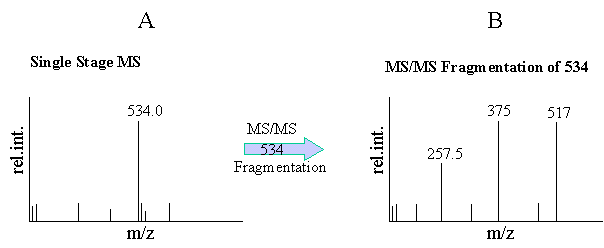Develop an MRM Transition534->375 |
|
A quantitative assay should be specific, accurate and sensitive. Assay development time should be as short as possible without sacrificing the aforementioned attributes. A mass spectrometry quantitation assay can satisfy these criteria. In the development of a transition the compound of interest is selected for MS/MS fragmentation. One way to develop and optimize a transition is to infuse the compound with a syringe pump. During the infusion of the compound the MS signal can be optimized in the full scan mode. MS/MS sensitivity will depend on how well your compound behaves in the full MS mode, anything that you can do to boost the full scan non-CID response will benefit the final MRM experiment. Next, the collision energy and collision gas can all be optimized to give the most abundant fragmentation. Care must be taken not to supply too much collision energy. The result of too much CE can be the loss of valuable stable fragment peaks. "How do I optimize for fragment peaks?", this can be accomplished by infusing the compound while performing MS/MS, pick a suitable fragment peak and monitor it's specific ion current while changing the collision energy and collision gas. Pick a collision energy and collision gas condition that gives the maximum response. Modern triple quadrupole mass spectrometers can perform this optimization automatically.
|
|
The optimized MS/MS spectrum is then inspected for a suitable fragment peak to monitor in the quantitative assay. As observed in spectrum A the parent mass of the compound is 534. It might appear to be a simple task to choose a fragment peak from the MS/MS spectrum B to complete the transition. Care must be taken not to choose a fragment peak too near to the parent peak. It is very common for compounds to readily lose water and or ammonia, for example 534-517= 17. Care must be taken not to choose the ammonia or water loss peaks for the MRM experiment because that would result in a less than unique transition. The transition 534->375 would be a good choice. Another warning is to take care and choose a stable peak. The fragment peak you choose to complete the transition must be a consistent peak that appears scan after scan with a consistent response while the standard compound is being infused. Hint: When optimizing MS conditions it is often better to simulate the conditions that will be experienced during the assay. For example if the assay is performed at a chromatographic flow rate of 400 ul/min and the compound elutes at 30% organic it is best to simulate these conditions while you are infusing the compound for optimization. This can be done by setting up the HPLC at the appropriate flow rate and organic composition. and then teeing in the compound for infusion. You will be the king of the MS assay if you take this hint. Also the first time we run a compound we do the 60/60 gradient to characterize it's hydrophobic character to see how it behaves on a C18 column. If you do this with all of your compounds you can create an elution library that can be used as a reference in future assays.
|
|
- Read about the need for an internal standard |
|
|
|
home
| disclaimer |
